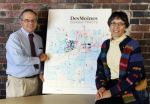(Press-News.org) AMES, Iowa -- The nation's poverty rate climbed to 14.3 percent -- the highest level since 1994 -- according to the Census Bureau's annual report on the economic well-being of U.S. households. That means one in seven Americans now live in poverty, and that may have an especially depressing effect on people living in bad neighborhoods, according to two Iowa State University researchers.
Daniel Russell, an Iowa State professor of human development and family studies; and Carolyn Cutrona, professor and chair of psychology, presented "Stressful Effects of Where You Live: Studying the Influence of Neighborhood Context Over Time," in August at the World Conference on Stress and Anxiety Research in Galway, Ireland. Their presentation summarized data taken from the Family and Community Health Study (FACHS), an ongoing ISU study of 800 African American families -- approximately half living in Iowa and half in Georgia -- that started in 1997.
Russell and Cutrona reported that negative neighborhood infrastructure can keep neighbors from forming social ties. And it's the absence of those social ties that have a small but significant impact on an individual's mental health.
"If you're living in neighborhoods where there's a lot of crime, gang activities and so forth, you see weaker social ties," said Russell, a noted loneliness researcher. "One of the things we tried to assess was essentially community support -- to what extent people in that neighborhood turned to others for child care, other forms of assistance -- and whether they socialize and know each other. And it's clear that in these negative neighborhoods there's this inverse relationship in terms of their various problems and lack of strong ties."
In neighborhoods where social disorder -- or a lack of social ties -- was perceived to be high, the effects on the subjects' perceived personal risk were amplified. The effects of personal risk were muted in neighborhoods with low social disorder.
"The effects of things going wrong in your own life are magnified when you live in one of these negative neighborhoods," said Cutrona, who presented related research this month to staff members for Iowa Sen. Tom Harkin. "So it affects all of us to have a sick family member, or lose our job, or to be robbed. But when that happens to someone in these neighborhoods, it increases the probability that the person will be diagnosed with a major depressive disorder over the next two years. Yet if the same event happened and you were in a more benign neighborhood, your chances of becoming clinically depressed were less."
Sixty-two percent of the study's participants subsequently moved to different neighborhoods between 1997 and 2005, with the rate of moving from specific neighborhoods ranging from 22 to 90 percent. "Neighborhood cohesion" was identified by subjects as the most desirable characteristic of their new neighborhoods. And people who lived in cohesive neighborhoods were much less likely to move away.
But the ISU researchers found that the lack of racism was the only factor that significantly improved depression among the African American subjects after they moved.
"If the new neighborhood was less racist overall -- not just their perception, but the perception of multiple people who lived in that neighborhood -- then the subjects' moods improved following that move," Cutrona said. "So it was not about moving to a wealthier neighborhood, or even a safer neighborhood, but moving to a less racist neighborhood that impacted depression levels."
The researchers emphasize that the study's sample does not solely reflect perceptions of low income families. Only about 20 percent of the families surveyed were below the poverty line and the sample included a wide range of family incomes, including some families that earned more than $200,000 per year.
"When we started the study, the average income of this study matched the average income of Iowans," Russell said.
But both Cutrona and Russell agree that it is the low-income subjects living in negative neighborhoods who are most vulnerable to prolonged depression.
"If you have to live in one of these neighborhoods, you may not have the resources for health insurance and good mental health care," Cutrona said. "And you may not have the support around you to say, 'This is depression and it's treatable.'"
Russell reports he and Cutrona have received funding from the National Institute of Mental Health to collaborate with researchers at the University of Iowa and the University of Georgia to study the role of genetic factors and neighborhood environments on depression in the FACHS sample.
INFORMATION:
Neighborhoods can have depressing effect on health, according to Iowa State study
Lack of neighborhood social ties that have an impact on an individual's mental health
2010-10-07
ELSE PRESS RELEASES FROM THIS DATE:
UD researcher on project team for NASA's first visit to the sun
2010-10-07
A University of Delaware researcher is helping to design instruments for a robotic space probe that will go where no other has gone before: the sun.
William Matthaeus, professor of physics and astronomy at UD, is involved in NASA's Solar Probe Plus project, which is slated to launch by 2018.
The unmanned spacecraft, the size of a small car, will plunge directly into the sun's atmosphere to help uncover answers to perplexing mysteries about the fiery ball of plasma at the center of our solar system.
"The experiments selected for Solar Probe Plus are specifically designed ...
Iowa State team calculates societal costs of five major crimes; finds murder at $17.25 million
2010-10-07
AMES, Iowa -- Murder takes an obvious toll on society in terms of the loss of human life, but what does it actually cost each time there's a murder? It's about $17.25 million according a recent Iowa State University study.
Matt DeLisi, an ISU associate professor of sociology and director of the criminal justice program, led a team of five Iowa State graduate students on the study of 654 convicted and incarcerated murderers. Expanding upon earlier monetization estimates, they calculated the costs of five crimes -- murder, rape, armed robbery, aggravated assault and burglary ...
Hormone acting as 'molecular glue' could boost plant immune systems
2010-10-07
EAST LANSING, Mich. — The discovery of a hormone acting like molecular glue could hold a key to bolstering plant immune systems and understanding how plants cope with environmental stress.
The study, which is featured in the Oct. 6 issue of Nature, reveals how the plant hormone jasmonate binds two proteins together – an emerging new concept in hormone biology and protein chemistry. The study also identifies the receptor's crystal structure to provide the first molecular view of how plants ward off attacks by insects and pathogens.
In short, the work explains how a highly ...
Patient-provider language barriers linked to worse diabetes control
2010-10-07
Patients who cannot discuss their diabetes with a doctor in their own language may have poorer health outcomes, even when interpreter services are available, according to a new study by researchers at UCSF and the Kaiser Permanente Division of Research.
The study found that, among Latino diabetes patients with limited English skills, those seen by non-Spanish speaking doctors were nearly twice as likely to have poor control of their blood sugar than those whose doctors spoke Spanish.
Findings will appear in the January 2011 issue of the Journal of General Internal ...
Vitamin D-ficiency common among orthopaedic surgery
2010-10-07
Forty-three percent of patients scheduled to undergo orthopaedic surgery have insufficient levels of vitamin D and two out of five of those patients had levels low enough to place them at risk for metabolic bone disease, according to a study published this month in the October 6th issue of the Journal of Bone and Joint Surgery (JBJS).
According to the National Institutes of Health (NIH) , vitamin D helps the body absorb calcium and is essential for bone growth and bone remodeling. Without sufficient vitamin D, bones can become thin, brittle or misshapen. People can obtain ...
Study provides data that can inform Atlantic sturgeon recovery efforts
2010-10-07
STONY BROOK, NY, October 6, 2010 - A first-of-its-kind study that tracked the oceanic migrations of adult Atlantic sturgeon that were caught and tagged in the Hudson River discovered that these fish move vast distances in the Atlantic Ocean, traveling as far south as Georgia and as far north as Nova Scotia, Canada. The findings indicate that recovery of Atlantic sturgeon fisheries will need to address long-range oceanic threats to the species in addition to local measures closer to spawning grounds. These results are particularly timely given the announcement on October ...
NASA loosens GRIP on Atlantic hurricane season
2010-10-07
NASA wrapped up one of its largest hurricane research efforts ever last week after nearly two months of flights that broke new ground in the study of tropical cyclones and delivered data that scientists will now be able to analyze for years to come.
While the 2010 hurricane season has been a rather quiet one for coastal dwellers, the churning meteorology of the Atlantic Ocean and Caribbean Sea seemed to cooperate well with the science goals of Genesis and Rapid Intensification Processes (GRIP) experiment. Those goals were designed to answer some of the most fundamental ...
Keeping blood pressure in check may benefit some African-Americans with kidney disease
2010-10-07
DALLAS – Oct. 7, 2010 – Keeping blood pressure at a low level in African-Americans with kidney disease may slow the progression of the condition in patients with proteinuria, UT Southwestern Medical Center researchers found in a national study published in The New England Journal of Medicine.
In the African-American Study of Kidney Disease and Hypertension, or AASK, trial of 1,094 patients, researchers found that keeping blood pressure readings at about 130/80 mm Hg reduced the risk of disease progression by 27 percent for patients with protein in the urine (proteinuria), ...
Breast density linked to increased risk of subsequent breast cancer
2010-10-07
PHILADELPHIA — Researchers at Kaiser Permanente have found that patients with a very early form of breast cancer (ductal carcinoma in situ or DCIS) who have higher mammographic density may be at increased risk for subsequent breast cancer, especially in the breast opposite to the one with the initial cancer.
These study results are published in Cancer Epidemiology, Biomarkers & Prevention, a journal of the American Association for Cancer Research.
Mammographic density refers to the proportion of the breast that appears dense on a mammogram; it is one of the strongest ...
Half-time gamblers give stock market insight
2010-10-07
Computer-modelled comparison of online football gamblers' behaviour during play and during half-time shows distinct real-time differences, begging the question what motivates betting behaviour when play is not underway?
Research published today, Thursday 7 October 2010, in New Journal of Physics (co-owned by the Institute of Physics and German Physical Society), details how researchers from Trinity College Dublin have analysed data and identified betting trends during the 2007-08 Champions' League Tournament.
Using a complete dataset from Betfair.com, drawn from bets ...
LAST 30 PRESS RELEASES:
Interaction of climate change and human activity and its impact on plant diversity in Qinghai-Tibet plateau
From addressing uncertainty to national strategy: an interpretation of Professor Lim Siong Guan’s views
Clinical trials on AI language model use in digestive healthcare
Scientists improve robotic visual–inertial trajectory localization accuracy using cross-modal interaction and selection techniques
Correlation between cancer cachexia and immune-related adverse events in HCC
Human adipose tissue: a new source for functional organoids
Metro lines double as freight highways during off-peak hours, Beijing study shows
Biomedical functions and applications of nanomaterials in tumor diagnosis and treatment: perspectives from ophthalmic oncology
3D imaging unveils how passivation improves perovskite solar cell performance
Enriching framework Al sites in 8-membered rings of Cu-SSZ-39 zeolite to enhance low-temperature ammonia selective catalytic reduction performance
AI-powered RNA drug development: a new frontier in therapeutics
Decoupling the HOR enhancement on PtRu: Dynamically matching interfacial water to reaction coordinates
Sulfur isn’t poisonous when it synergistically acts with phosphine in olefins hydroformylation
URI researchers uncover molecular mechanisms behind speciation in corals
Chitin based carbon aerogel offers a cleaner way to store thermal energy
Tracing hidden sources of nitrate pollution in rapidly changing rural urban landscapes
Viruses on plastic pollution may quietly accelerate the spread of antibiotic resistance
Three UH Rainbow Babies & Children’s faculty elected to prestigious American Pediatric Society
Tunnel resilience models unveiled to aid post-earthquake recovery
Satellite communication systems: the future of 5G/6G connectivity
Space computing power networks: a new frontier for satellite technologies
Experiments advance potential of protein that makes hydrogen sulfide as a therapeutic target for Alzheimer’s disease
Examining private equity’s role in fertility care
Current Molecular Pharmacology achieves a landmark: real-time CiteScore advances to 7.2
Skeletal muscle epigenetic clocks developed using postmortem tissue from an Asian population
Estimating unemployment rates with social media data
Climate policies can backfire by eroding “green” values, study finds
Too much screen time too soon? A*STAR study links infant screen exposure to brain changes and teen anxiety
Global psychiatry mourns Professor Dan Stein, visionary who transformed mental health science across Africa and beyond
KIST develops eco-friendly palladium recovery technology to safeguard resource security
[Press-News.org] Neighborhoods can have depressing effect on health, according to Iowa State studyLack of neighborhood social ties that have an impact on an individual's mental health




